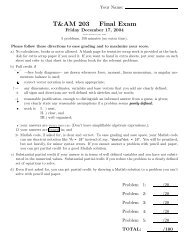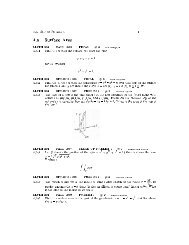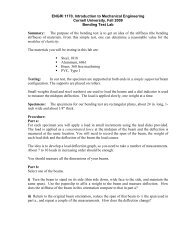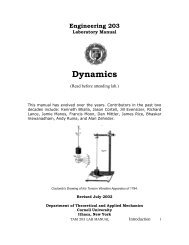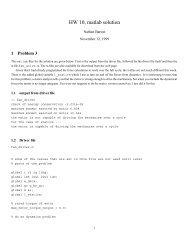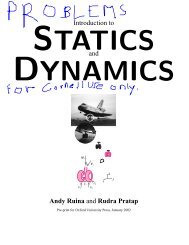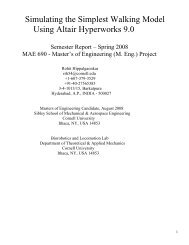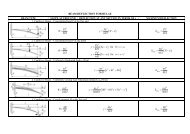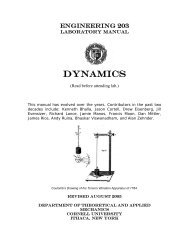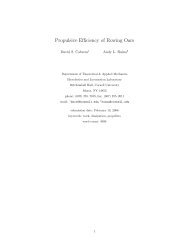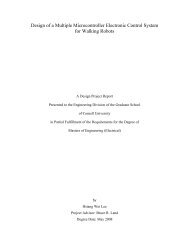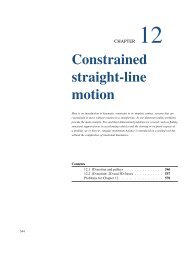You also want an ePaper? Increase the reach of your titles
YUMPU automatically turns print PDFs into web optimized ePapers that Google loves.
<strong>Partial</strong> Solutions <strong>Manual</strong><strong>Ruina</strong> and PratapIntroduction to Statics and DynamicsThis draft: August 21, 2010Have a suggestion? Want to contribute a solution?Contact ruina@cornell.edu with Subject: Solutions <strong>Manual</strong>Note, the numbering of hand-written solutions is most-often wrong (correspondingto an old numbering scheme). The hand-written problem numbersshould be ignored.
2 Introduction to Statics and Dynamics, c <strong>Andy</strong> <strong>Ruina</strong> and Rudra Pratap 1992-2009.
9.1.15 Consider a force F .t/ acting ona cart over a 3 second span. In case (a),the force acts in two impulses of one secondduration each as shown in fig. 9.1.15.In case (b), the force acts continuously fortwo seconds and then goes to zero. Giventhat the mass of the cart is 10 kg, v.0 s/ D0, and F 0 D 10 N, for each force profile,a) Find the speed of the cart at the endof 3 seconds, andb) Find the distance travelled by thecart in 3 seconds.Comment on your answers for the twocases.F(t)F 0(a)0 1 2 3F(t)F 0(b)0 1 2 3Filename:pfigure9-1-fcompareProblem 9.15t (sec)t (sec)Introduction to Statics and Dynamics, c <strong>Andy</strong> <strong>Ruina</strong> and Rudra Pratap 1992-2009. 3
4 Chapter 9.1. Force and motion in 1D Problem 9.1.169.1.16 A car of mass m is accelerated byapplying a triangular force profile shownin fig. 9.1.16(a). Find the speed of the carat t D T seconds. If the same speed isto be achieved at t D T seconds with asinusoidal force profile, F .t/ D F s sin tT ,find the required force magnitude F s . Isthe peak higher or lower? Why?F(t)F T(a)0F(t)T/2TtF s(b)0T/2TtProblem 9.16Filename:pfigure9-1-fcompare2Introduction to Statics and Dynamics, c <strong>Andy</strong> <strong>Ruina</strong> and Rudra Pratap 1992-2009.
Chapter 9.1. Force and motion in 1D Problem 9.1.22 59.1.22 A grain of sugar falling throughhoney has a negative acceleration proportionalto the difference between its velocityand its ‘terminal’ velocity, which is aknown constant v t . Write this sentence asa differential equation, defining any constantsyou need. Solve the equation assumingsome given initial velocity v 0 .Introduction to Statics and Dynamics, c <strong>Andy</strong> <strong>Ruina</strong> and Rudra Pratap 1992-2009.
6 Chapter 9.1. Force and motion in 1D Problem 9.1.269.1.26 A bullet penetrating flesh slowsapproximately as it would if penetratingwater. The drag on the bullet is aboutF D D c w v 2 A=2 where w is the densityof water, v is the instantaneous speedof the bullet, A is the cross sectional areaof the bullet, and c is a drag coefficientwhich is about c 1. Assume that thebullet has mass m D l AL where l isthe density of lead, A is the cross sectionalarea of the bullet and L is the lengthof the bullet (approximated as cylindrical).Assume m D 2 grams, entering velocityv 0 D 400 m=s, l = w D 11:3, and bulletdiameter d D 5:7 mm.a) Plot the bullet position vs time.b) Assume the bullet has effectivelystopped when its speed has droppedto 5 m=s, what is its total penetrationdistance?c) According to the equations impliedabove, what is the penetration distancein the limit t ! 1?d) How would you change the modelto make it more reasonable in itspredictions for long time?Introduction to Statics and Dynamics, c <strong>Andy</strong> <strong>Ruina</strong> and Rudra Pratap 1992-2009.
Chapter 9.1. Force and motion in 1D Problem 9.1.26 (continued) 7Introduction to Statics and Dynamics, c <strong>Andy</strong> <strong>Ruina</strong> and Rudra Pratap 1992-2009.
8 Chapter 9.1. Force and motion in 1D Problem 9.1.26 (continued)Introduction to Statics and Dynamics, c <strong>Andy</strong> <strong>Ruina</strong> and Rudra Pratap 1992-2009.
Chapter 9.1. Force and motion in 1D Problem 9.1.26 (continued) 91.8Plot of position vs time1.61.41.2position (m)10.80.60.40.200 5 10time (s)Introduction to Statics and Dynamics, c <strong>Andy</strong> <strong>Ruina</strong> and Rudra Pratap 1992-2009.
10 Chapter 9.2. Energy methods in 1D Problem 9.2.39.2.3 A force F D F 0 sin.ct/ acts on aparticle with mass m D 3 kg which hasposition x D 3 m, velocity v D 5 m=s att D 2 s. F 0 D 4 N and c D 2= s. Att D 2 s evaluate (give numbers and units):a) a,b) E K ,c) P ,d) P E K ,e) the rate at which the force is doingwork.Introduction to Statics and Dynamics, c <strong>Andy</strong> <strong>Ruina</strong> and Rudra Pratap 1992-2009.
Chapter 9.2. Energy methods in 1D Problem 9.2.3 (continued) 11Introduction to Statics and Dynamics, c <strong>Andy</strong> <strong>Ruina</strong> and Rudra Pratap 1992-2009.
12 Chapter 9.2. Energy methods in 1D Problem 9.2.109.2.10 A kid (m D 90 lbm) stands on ah D 10 ft wall and jumps down, acceleratingwith g D 32 ft=s 2 . Upon hitting theground with straight legs, she bends themso her body slows to a stop over a distanced D 1 ft. Neglect the mass of her legs. Assumeconstant deceleration as she brakesthe fall.a) What is the total distance her bodyfalls?b) What is the potential energy lost?c) How much work must be absorbedby her legs?d) What is the force of her legs on herbody? Answer in symbols, numbersand numbers of body weight (i.e.,find F=mg).Introduction to Statics and Dynamics, c <strong>Andy</strong> <strong>Ruina</strong> and Rudra Pratap 1992-2009.
Chapter 9.2. Energy methods in 1D Problem 9.2.11 139.2.11 In traditional archery, when pullingan arrow back the force increases approximatelylinearly up to the peak ‘draw force’F draw that varies from about F draw D25 lbf for a bow made for a small person toabout F draw D 75 lbf for a bow made fora big strong person. The distance the arrowis pulled back, the draw length `draw ,varies from about `draw D 2 ft for a smalladult to about 30 inch for a big adult. Anarrow has mass of about 300 grain (1 grain 64:8milli gm, so an arrow has mass ofabout 19:44 20 gm 3=4 ounce). Giveall answers in symbols and numbers.a) What is the range of speeds you canexpect an arrow to fly?b) What is the range of heights an arrowmight go if shot straight up (it’sa bad approximation, but for thisproblem neglect air friction)?Introduction to Statics and Dynamics, c <strong>Andy</strong> <strong>Ruina</strong> and Rudra Pratap 1992-2009.
14 Chapter 9.2. Energy methods in 1D Problem 9.2.11 (continued)Introduction to Statics and Dynamics, c <strong>Andy</strong> <strong>Ruina</strong> and Rudra Pratap 1992-2009.
Chapter 9.2. Energy methods in 1D Problem 9.2.16 159.2.16 The power available to a verystrong accelerating cyclist over short periodsof time (up to, say, about 1 minute) isabout 1 horsepower. Assume a rider startsfrom rest and uses this constant power. Assumea mass (bike + rider) of 150 lbm, arealistic drag force of :006 lbf=. ft= s/ 2 v 2 .Neglect other drag forces.a) What is the peak (steady state)speed of the cyclist?b) Using analytic or numerical methodsmake an accurate plot of speedvs. time.c) What is the acceleration as t ! 1in this solution?d) What is the acceleration as t ! 0in your solution?e) How would you improve the modelto fix the problem with the answerabove?Introduction to Statics and Dynamics, c <strong>Andy</strong> <strong>Ruina</strong> and Rudra Pratap 1992-2009.
16 Chapter 9.2. Energy methods in 1D Problem 9.2.16 (continued)Introduction to Statics and Dynamics, c <strong>Andy</strong> <strong>Ruina</strong> and Rudra Pratap 1992-2009.
Chapter 9.2. Energy methods in 1D Problem 9.2.16 (continued) 17Introduction to Statics and Dynamics, c <strong>Andy</strong> <strong>Ruina</strong> and Rudra Pratap 1992-2009.
18 Chapter 9.3. Elementary vibration analysis Problem 9.3.69.3.6 A spring k with rest length `0 is attachedto a mass m which slides frictionlesslyon a horizontal ground as shown.At time t D 0 the mass is released fromrest with the spring stretched a distance d.Measure the mass position x relative to thewall.a) What is the acceleration of the massjust after release?b) Find a differential equation whichdescribes the horizontal motion x ofthe mass.c) What is the position of the mass atan arbitrary time t?d) What is the speed of the mass whenit passes through x D `0 (the positionwhere the spring is relaxed)?Filename:s97f1l 0Problem 9.6dmIntroduction to Statics and Dynamics, c <strong>Andy</strong> <strong>Ruina</strong> and Rudra Pratap 1992-2009.
Chapter 9.3. Elementary vibration analysis Problem 9.3.6 (continued) 19Introduction to Statics and Dynamics, c <strong>Andy</strong> <strong>Ruina</strong> and Rudra Pratap 1992-2009.
20 Chapter 9.3. Elementary vibration analysis Problem 9.3.6 (continued)Introduction to Statics and Dynamics, c <strong>Andy</strong> <strong>Ruina</strong> and Rudra Pratap 1992-2009.
Chapter 9.3. Elementary vibration analysis Problem 9.3.6 (continued) 21Introduction to Statics and Dynamics, c <strong>Andy</strong> <strong>Ruina</strong> and Rudra Pratap 1992-2009.
22 Chapter 9.3. Elementary vibration analysis Problem 9.3.109.3.10 Mass m hangs from a springwith constant k and which has the lengthl 0 when it is relaxed (i.e., when no mass isattached). It only moves vertically.a) Draw a Free Body Diagram of themass.b) Write the equation of linear momentumbalance.c) Reduce this equation to a standarddifferential equation in x, the positionx of the mass.d) Verify that one solution is that x.t/is constant at x D l 0 C mg=k.e) What is the meaning of that solution?(That is, describe in wordswhat is going on.)f) Define a new variable Ox D x .l 0 Cmg=k/. Substitute x D Ox C .l 0 Cmg=k/ into your differential equationand note that the equation issimpler in terms of the variable Ox.g) Assume that the mass is releasedfrom an an initial position of x DD. What is the motion of the mass?h) What is the period of oscillation ofthis oscillating mass?i) Why might this solution not makephysical sense for a long, softspring if the initial stretch is large.In other words, what is wrong withthis solution if D > `0 C 2mg=k?xFilename:pg141-1Problem 9.10mkl 0Introduction to Statics and Dynamics, c <strong>Andy</strong> <strong>Ruina</strong> and Rudra Pratap 1992-2009.
Chapter 9.3. Elementary vibration analysis Problem 9.3.12 239.3.12 A person jumps on a trampoline.The trampoline is modeled as having aneffective vertical undamped linear springwith stiffness k D 200 lbf= ft. The personis modeled as a rigid mass m D 150 lbm.g D 32:2 ft=s 2 .a) What is the period of motion if theperson’s motion is so small that herfeet never leave the trampoline?b) What is the maximum amplitude ofmotion (amplitude of the sine wave)for which her feet never leave thetrampoline?c) (harder) If she repeatedly jumps sothat her feet clear the trampoline bya height h D 5 ft, what is the periodof this motion (note, the contacttime is not exactly half of a vibrationperiod)? [Hint, a neat graphof height vs time will help.]Filename:pfigure3-trampolineProblem 9.12: A person jumps on a trampoline.Introduction to Statics and Dynamics, c <strong>Andy</strong> <strong>Ruina</strong> and Rudra Pratap 1992-2009.
24 Chapter 9.3. Elementary vibration analysis Problem 9.3.12 (continued)Introduction to Statics and Dynamics, c <strong>Andy</strong> <strong>Ruina</strong> and Rudra Pratap 1992-2009.
Chapter 9.3. Elementary vibration analysis Problem 9.3.12 (continued) 25Introduction to Statics and Dynamics, c <strong>Andy</strong> <strong>Ruina</strong> and Rudra Pratap 1992-2009.
26 Chapter 9.4. Coupled motion in 1D Problem 9.4.14The primary emphasis of this sectionis setting up correct differential equations(without sign errors) and solving theseequations on the computer.9.4.14 x 1 .t/ and x 2 .t/ are measured positionson two points of a vibrating structure.x 1 .t/ is shown. Some candidatesfor x 2 .t/ are shown. Which of the x 2 .t/could possibly be associated with a normalmode vibration of the structure? Answer“could” or “could not” next to each choiceand briefly explain your answer (If a curvelooks like it is meant to be a sine/cosinecurve, it is.)X 1 (t)a)b)c)d)e)X 2 ?X 2?X 2 ?X 2?X 2 ?Filename:pfigure-blue-144-1Problem 9.14Introduction to Statics and Dynamics, c <strong>Andy</strong> <strong>Ruina</strong> and Rudra Pratap 1992-2009.
Chapter 9.4. Coupled motion in 1D Problem 9.4.17 279.4.17 Two masses are connected to fixedsupports and each other with the threesprings and dashpot shown. The force Facts on mass 2. The displacements x 1 andx 2 are defined so that x 1 D x 2 D 0 whenthe springs are unstretched. The ground isfrictionless. The governing equations forthe system shown can be written in firstorder form if we define v 1 Px 1 andv 2 Px 2 .a) Write the governing equations in aneat first order form. Your equationsshould be in terms of any or allof the constants m 1 , m 2 , k 1 , k 2 ,k 3 ,C , the constant force F , and t. Gettingthe signs right is important.b) Write computer commands to findand plot v 1 .t/ for 10 units of time.Make up appropriate initial conditions.c) For constants and initial conditionsof your choosing, plot x 1 vs t forenough time so that decaying erraticoscillations can be observed.x 2Fcx 1k 1 k 2 m 2 k 3m 1Filename:p-f96-f-3Problem 9.17Introduction to Statics and Dynamics, c <strong>Andy</strong> <strong>Ruina</strong> and Rudra Pratap 1992-2009.
28 Chapter 9.4. Coupled motion in 1D Problem 9.4.17 (continued)Introduction to Statics and Dynamics, c <strong>Andy</strong> <strong>Ruina</strong> and Rudra Pratap 1992-2009.
Chapter 9.4. Coupled motion in 1D Problem 9.4.17 (continued) 29Introduction to Statics and Dynamics, c <strong>Andy</strong> <strong>Ruina</strong> and Rudra Pratap 1992-2009.
30 Chapter 9.4. Coupled motion in 1D Problem 9.4.239.4.23 For the three-mass system shown,assume x 1 D x 2 D x 3 D 0 when allthe springs are fully relaxed. One of thenormal modes is described with the initialcondition .x 10 ; x 2 ; x 3 / D .1; 0; 1/.a) What is the angular frequency !for this mode? Answer in terms ofL; m; k, and g. (Hint: Note thatin this mode of vibration the middlemass does not move.)b) Make a neat plot of x 2 versus x 1for one cycle of vibration with thismode.L L L Lx 1 x 2 x 3kmkm km kFilename:pfigure-blue-160-2Problem 9.23Introduction to Statics and Dynamics, c <strong>Andy</strong> <strong>Ruina</strong> and Rudra Pratap 1992-2009.
Chapter 9.4. Coupled motion in 1D Problem 9.4.23 (continued) 31Introduction to Statics and Dynamics, c <strong>Andy</strong> <strong>Ruina</strong> and Rudra Pratap 1992-2009.
32 Chapter 9.4. Coupled motion in 1D Problem 9.4.23 (continued)Introduction to Statics and Dynamics, c <strong>Andy</strong> <strong>Ruina</strong> and Rudra Pratap 1992-2009.
Chapter 9.5. 1D Collisions Problem 9.5.6 339.5.6 Before a collision two particles,m A D 7 kg and m B D 9 kg, have velocitiesof vA D 6 m=s and v D 2 m=s. TheBcoefficient of restitution is e D :5. Findthe impulse of mass A on mass B and thevelocities of the two masses after the collision.Introduction to Statics and Dynamics, c <strong>Andy</strong> <strong>Ruina</strong> and Rudra Pratap 1992-2009.
34 Chapter 9.5. 1D Collisions Problem 9.5.6 (continued)Introduction to Statics and Dynamics, c <strong>Andy</strong> <strong>Ruina</strong> and Rudra Pratap 1992-2009.
Chapter 9.5. 1D Collisions Problem 9.5.6 (continued) 35Introduction to Statics and Dynamics, c <strong>Andy</strong> <strong>Ruina</strong> and Rudra Pratap 1992-2009.
36 Chapter 9.5. 1D Collisions Problem 9.5.6 (continued)Problem 9.84If you assumed vA + = 6 m/s, than the following answers will changed) 6 kg m/sf) 14 kg m/sg) −4 kg m/s. You get this by solving vB + = 7 m/sh) 4 kg m/sj) 67 Jk) 0.21Introduction to Statics and Dynamics, c <strong>Andy</strong> <strong>Ruina</strong> and Rudra Pratap 1992-2009.
Chapter 9.5. 1D Collisions Problem 9.5.10 379.5.10 A basketball with mass m b isdropped from height h onto the hard solidground on which it has coefficient of restitutione b . Just on top of the basketball,falling with it and then bouncing againstit after the basketball hits the ground, is asmall rubber ball with mass m r that has acoefficient of restitution e r with the basketball.a) In terms of some or all of m b , m r ,h, g, e b and e r how high does therubber ball bounce (measure heightrelative to the collision point)?b) Assuming the coefficients of restitutionare less than or equal toone, for given h, what mass andrestitution parameters maximize theheight of the bounce of the rubberball and what is that height?Introduction to Statics and Dynamics, c <strong>Andy</strong> <strong>Ruina</strong> and Rudra Pratap 1992-2009.
38 Chapter 9.5. 1D Collisions Problem 9.5.10 (continued)Introduction to Statics and Dynamics, c <strong>Andy</strong> <strong>Ruina</strong> and Rudra Pratap 1992-2009.
10.1.22 An object C of mass 2 kg is pulledby three strings as shown. The accelerationof the object at the position shown is a D0:6O{ 0:2 O| C 2:0O km=s 2 .a) Draw a free body diagram of themass.b) Write the equation of linear momentumbalance for the mass. Use’s as unit vectors along the strings.c) Find the three tensions T 1 , T 2 , andT 3 at the instant shown. You mayfind these tensions by using handalgebra with the scalar equations,xusing a computer with the matrixequation, or by using a cross producton the vector equation.zT 1T 2T 31.5mmFilename:pfigure-s94h2p9Problem 10.22C4m2m1m2myIntroduction to Statics and Dynamics, c <strong>Andy</strong> <strong>Ruina</strong> and Rudra Pratap 1992-2009. 39
40 Chapter 10.1. Dynamics of a particle in space Problem 10.1.22 (continued)Introduction to Statics and Dynamics, c <strong>Andy</strong> <strong>Ruina</strong> and Rudra Pratap 1992-2009.
Chapter 10.1. Dynamics of a particle in space Problem 10.1.26 4110.1.26 Bungy Jumping. In a relativelysafe bungy jumping system, people jumpup from the ground while being pulled upby a rope that runs over a pulley at O andis connected to a stretched spring anchoredat B. The ideal pulley has negligible size,mass, and friction. For the situation shownthe spring AB has rest length `0 D 2 m anda stiffness of k D 200 N= m. The inextensiblemassless rope from A to P has length`r D 8 m, the person has a mass of 100 kg.Take O to be the origin of an xy coordinatesystem aligned with the unit vectors O{ andO|a) Assume you are given the positionof the person * r D xO{ C y O| and thevelocity of the person v D PxO{ CPy O|. Find her acceleration in termsof some or all of her position, hervelocity, and the other parametersgiven. Then use the numbers given,where supplied, in your final answer.ĵOb) Given that bungy jumper’s initialposition and velocity are * r 0 D1 mO{ 5 m O| and v 0 D 0 write computercommands to find her positionat t D p = 2 s.c) Find the answer to part (b) withpencil and paper (that is, find ananalytic solution to the differentialequations, a final numerical answeris desired).Filename:s97p1-3îAPm10 mkBg = 10 m/s 2ground, no contactafter jump offProblem 10.26: Conceptual setup for abungy jumping system.Introduction to Statics and Dynamics, c <strong>Andy</strong> <strong>Ruina</strong> and Rudra Pratap 1992-2009.
42 Chapter 10.1. Dynamics of a particle in space Problem 10.1.26 (continued)Introduction to Statics and Dynamics, c <strong>Andy</strong> <strong>Ruina</strong> and Rudra Pratap 1992-2009.
Chapter 10.1. Dynamics of a particle in space Problem 10.1.26 (continued) 43Introduction to Statics and Dynamics, c <strong>Andy</strong> <strong>Ruina</strong> and Rudra Pratap 1992-2009.
44 Chapter 10.1. Dynamics of a particle in space Problem 10.1.3010.1.30 The equations of motion fromproblem ?? are nonlinear and cannot besolved in closed form for the position ofthe baseball. Instead, solve the equationsnumerically. Make a computer simulationof the flight of the baseball, as follows.a) Convert the equation of motion intoa system of first order differentialequations.b) Pick values for the gravitationalconstant g, the coefficient of resistanceb, and initial speed v 0 , solvefor the x and y coordinates of theball and make a plots its trajectoryfor various initial angles 0 .c) Use Euler’s, Runge-Kutta, or othersuitable method to numerically integratethe system of equations.d) Use your simulation to find the initialangle that maximizes the distanceof travel for ball, with andwithout air resistance.e) If the air resistance is very high,what is a qualitative description forthe curve described by the path ofthe ball? Show this with an accurateplot of the trajectory. (Make sure tointegrate long enough for the ball toget back to the ground.)Introduction to Statics and Dynamics, c <strong>Andy</strong> <strong>Ruina</strong> and Rudra Pratap 1992-2009.
Chapter 10.1. Dynamics of a particle in space Problem 10.1.30 (continued) 4510.30 (continued)b). See attached codes and results%problem 10.30(a)function solution1030a%solution to 10.30%September 23,2008b=1; m=1; g=10; % give values for b,m and g here%Initial conditions and time spantspan=[0:0.001:5]; %integrate for 50 secondsx0=0;y0=0; %initial positionv0=50; %magnitude of initial velocity (m/s)theta0=20; %angle of initial velocity (in degrees)z0=[x0,y0,v0*cos(theta0*pi/180),v0*sin(theta0*pi/180)]';%solves the ODEs[t,z] = ode45(@rhs,tspan,z0,[],b,m,g);%Unpack the variablesx= z(:,1);y =z(:,2);v_x = z(:,3);v_y=z(:,4);%plot the resultsplot(x,y);xlabel('x(m)');ylabel('y(m)');%set grid,xmin,xmax,ymin,ymaxaxis([0,5,0,5]);title(['Plot of Trajectory for theta= ',num2str(theta0),' degrees']);end%-----------------------------------------------------------------------%function zdot = rhs(t,z,b,m,g)%function to define ODEx=z(1); y=z(2); v_x=z(3); v_y=z(4);%the linear momentum balance eqnsxdot=v_x;v_xdot=-(b/m)*v_x*(v_x^2+v_y^2)^0.5;ydot=v_y;Introduction to Statics and Dynamics, c <strong>Andy</strong> <strong>Ruina</strong> and Rudra Pratap 1992-2009.
46 Chapter 10.1. Dynamics of a particle in space Problem 10.1.30 (continued)v_ydot=-g-(b/m)*v_y*(v_x^2+v_y^2)^0.5;zdot=[xdot; ydot; v_xdot; v_ydot]; %this is what the function returns (column vector)end%-----------------------------------------------------------------------%Introduction to Statics and Dynamics, c <strong>Andy</strong> <strong>Ruina</strong> and Rudra Pratap 1992-2009.
Chapter 10.1. Dynamics of a particle in space Problem 10.1.30 (continued) 47c). Disregard this question. This question intends to ask you develop your own ode solver similarto ode45, using Euler’s method or more sophisticated method (Ruger-Kutta method).d). To find out x distance, we use ‘stopevent’ to terminate the integration at y=0. Then loop overfor theta from 0.1 to 89.1 degree with an increment of 1 degree.%problem 10.30(d)function solution1030d%solution to 10.30%September 23,2008b=1; m=1; g=10; % give values for b,m and g here%Initial conditions and time spantspan=[0 50]; %integrate for 50 secondsx0=0;y0=0; %initial positionv0=50; %magnitude of initial velocity (m/s)theta0=[0.1:1:89.1]'; %angle of initial velocity (in degrees)distance=zeros(size(theta0)); %arrays to record x distance at y=0 for each anglefor i=1:length(theta0)Introduction to Statics and Dynamics, c <strong>Andy</strong> <strong>Ruina</strong> and Rudra Pratap 1992-2009.
48 Chapter 10.1. Dynamics of a particle in space Problem 10.1.30 (continued)z0=[x0,y0,v0*cos(theta0(i)*pi/180),v0*sin(theta0(i)*pi/180)]';options=odeset('events', @stopevent);%solves the ODEs[t,z] = ode45(@rhs,tspan,z0,options,b,m,g);%Unpack the variablesx= z(:,1);distance(i)=x(end);% the last component of x is the distance we wantendplot(theta0,distance,'*')xlabel('theta(degrees)');ylabel('distance(m)');%set grid,xmin,xmax,ymin,ymaxtitle(['plot of x distance for various theta']);[maxd,j]=max(distance);fprintf(1,'\nThe maximum distance is %6.4f m when theta=%2.0f degrees\n', maxd,theta0(j));%print the resultsend%-----------------------------------------------------------------------%function zdot = rhs(t,z,b,m,g)%function to define ODEx=z(1); y=z(2); v_x=z(3); v_y=z(4);%the linear momentum balance eqnsxdot=v_x;v_xdot=-(b/m)*v_x*(v_x^2+v_y^2)^0.5;ydot=v_y;v_ydot=-g-(b/m)*v_y*(v_x^2+v_y^2)^0.5;zdot=[xdot; ydot; v_xdot; v_ydot]; %this is what the function returns (column vector)end%-----------------------------------------------------------------------%function [value, isterminal, dir]= stopevent(t,z,b,m,g,v0,theta)% terminate the integration at y=0x=z(1);y=z(2);value= y;isterminal=1;dir=-1;endIntroduction to Statics and Dynamics, c <strong>Andy</strong> <strong>Ruina</strong> and Rudra Pratap 1992-2009.
Chapter 10.1. Dynamics of a particle in space Problem 10.1.30 (continued) 49Matlab out put: The maximum distance is 3.3806 m when theta=23 degrees10.30 (Continued)The x distance at y=0 for various theta is plotted belowe). Use the code for (a) and change b to a very large number, 100000. The trajectory looks likewhich is approximately a triangle.,Introduction to Statics and Dynamics, c <strong>Andy</strong> <strong>Ruina</strong> and Rudra Pratap 1992-2009.
50 Chapter 10.1. Dynamics of a particle in space Problem 10.1.30 (continued)10.30 Another solution (more detailed)The m file attached does the following.a) uses events and x(end) to calculate range.b) has that embedded in a loop so that there is an angle(i) anda range(i)c) Makes a nice plot of range vs angled) uses MAX to find the maximum range and corresponding anglee) has good numerics to show that the trajectory shape converges toa triangle as the speed -> infinity.Introduction to Statics and Dynamics, c <strong>Andy</strong> <strong>Ruina</strong> and Rudra Pratap 1992-2009.
Chapter 10.1. Dynamics of a particle in space Problem 10.1.30 (continued) 51function baseball_trajectory% Calculates the trajectory of a baseball.% Calculates maximum range for given speed,% with and without air friction.% Shows shape of path at high speed.disp(['Start time: ' datestr(now)])cla% (a) ODEs are in the function rhs far below.% The 'event' fn that stops the integration% when the ball hits the ground is in 'eventfn'% even further below.% (b) Coefficients for a real baseball taken% from a google search, which finds a paper% Sawicki et al, Am. J. Phys. 71(11), Nov 2003.% Greg Sawicki, by the way, learned some dynamics% in TAM 203 from <strong>Ruina</strong> at Cornell.% All parameters in MKS.m = 0.145; % mass of baseball, 5.1 ozrho = 1.23; % density of air in kg/m^3r = 0.0366; % baseball radius (1.44 in)A = pi*r^2; % cross sectional area of ballC_d = 0.35; % varies, this is typicalg = 9.81; % typical g on earthb = C_d*rho*A/2; % net coeff of v^2 in drag force%%%%%%%%%%%%%%%%%%%%%%%%%%%%%%%%%%%%%%%%%%%%%%%% (b-d) Use typical homerun hit speed and look% at various angles of hit.tspan=linspace(0,100,1001); % give plenty of timen = 45; % number of simulationsangle = linspace(1,89,n); % launch from 1 to 89 degreesr0=[0 0]'; % Launch x and y position.% First case: No air friction.b = 0;subplot(3,2,1)hold off% Try lots of launch angles, one simulation for% each launch angle.for i = 1:ninspeed = 44; % typical homerun hit (m/s), 98 mph.theta0 = angle(i)*pi/180; % initial angle this simulationv0=inspeed*[cos(theta0) sin(theta0)]'; %launch velocityz0=[r0; v0]; % initial position and velocityIntroduction to Statics and Dynamics, c <strong>Andy</strong> <strong>Ruina</strong> and Rudra Pratap 1992-2009.
52 Chapter 10.1. Dynamics of a particle in space Problem 10.1.30 (continued)options=odeset('events',@eventfn);[t zarray]=ode45(@rhs,tspan,z0,options,g,b,m); %Solve ODEx=zarray(:,1); y=zarray(:,2); %Unpack positionsrange(i)= x(end); % x value at end, when ball hits groundplot(x,y); title('Jane Cho: Baseball trajectories, no air friction')xlabel('x, meters'); ylabel('y, meters'); axis('equal')axis([0 200 0 200])hold on % save plot for over-writingend % end of for loop for no-friction trajectories%Plot range vs angle, no friction casesubplot(3,2,2); hold off;plot(angle,range);title('Range vs hit angle, no air friction')xlabel('Launch angle, in degrees')ylabel('Hit distance, in meters')% Pick out best angle and distance[bestx besti] = max(range);disp(['No friction case:'])best_theta_deg = angle(besti)bestx% Second case: WITH air friction% Identical to code above but now b is NOT zero.b = C_d*rho*A/2; % net coeff of v^2 in drag forcesubplot(3,2,3)hold off % clear plot overwrites% Try lots of launch anglesfor i = 1:n %inspeed = 44; % typical homerun hit (m/s), 98 mph.theta0 = angle(i)*pi/180; % initial angle this simulationv0=inspeed*[cos(theta0) sin(theta0)]'; %launch velocityz0=[r0; v0]; % initial position and velocityoptions=odeset('events',@eventfn);[t zarray]=ode45(@rhs,tspan,z0,options,g,b,m); %Solve ODEx=zarray(:,1); y=zarray(:,2); %Unpack positionsrange(i)= x(end); % x value at end, when ball hits groundplot(x,y); title('Baseball trajectories, with air friction')xlabel('x, meters'); ylabel('y, meters'); axis('equal')axis([0 120 0 120])Introduction to Statics and Dynamics, c <strong>Andy</strong> <strong>Ruina</strong> and Rudra Pratap 1992-2009.
Chapter 10.1. Dynamics of a particle in space Problem 10.1.30 (continued) 53hold on % save plot for over-writingend % end of for loop for with-friction trajectories%Plot range vs angle, no friction casesubplot(3,2,4);plot(angle,range);title('Range vs hit angle, with air friction')xlabel('Launch angle, in degrees')ylabel('Hit distance, in meters')%Find Max range and corresponding launch angle[bestx besti] = max(range);disp(['With Friction:'])best_theta_deg = angle(besti)bestx%%%%%%%%%%%%%%%%%%%%%%%%%%% Now look at trajectories at a variety of speeds% Try lots of launch anglessubplot(3,2,6)hold offspeeds = 10.^linspace(1,8,30); % speeds from 1 to 100 million m/sfor i = 1:30 %inspeed = speeds(i); % typical homerun hit (m/s), 98 mph.theta0 = pi/4; % initial angle is 45 degrees at all speedsv0=inspeed*[cos(theta0) sin(theta0)]'; %launch velocityz0=[r0; v0]; % initial position and velocityoptions=odeset('events',@eventfn);[t zarray]=ode45(@rhs,tspan,z0,options,g,b,m); %Solve ODEx=zarray(:,1); y=zarray(:,2); %Unpack positionsrange(i)= x(end); % x value at end, when ball hits groundplot(x,y); title('Trajectories, with air friction, various speeds ')xlabel('x, meters'); ylabel('y, meters'); axis('equal')axis([0 2000 0 2000])hold on % save plot for over-writingend % end of for loop for range at various speedsdisp(['End time: ' datestr(now)])end % end of Baseball_trajectory.m%%%%%%%%%%%%%%%%%%%%%%%%%%%%%%%%%%%%%% Governing Ord Diff Eqs.Introduction to Statics and Dynamics, c <strong>Andy</strong> <strong>Ruina</strong> and Rudra Pratap 1992-2009.
54 Chapter 10.1. Dynamics of a particle in space Problem 10.1.30 (continued)function zdot=rhs(t,z,g,b,m)% Unpack the variablesx=z(1); y=z(2);vx=z(3); vy=z(4);%The ODEsxdot=vx; ydot=vy; v = sqrt(vx^2+vy^2);vxdot=-b*vx*v/m;vydot=-b*vy*v/m - g;zdot= [xdot;ydot;vxdot;vydot]; % Packed up again.end%%%%%%%%%%%%%%%%%%%%%%%%%%%%%%%%%%%%%% 'Event' that ball hits the groundfunction [value isterminal dir] = eventfn(t,z,g,b,m)y=z(2);value = y; % When this is zero, integration stopsisterminal = 1; % 1 means stop.dir= -1; % -1 means ball is falling when it hitsendIntroduction to Statics and Dynamics, c <strong>Andy</strong> <strong>Ruina</strong> and Rudra Pratap 1992-2009.
Chapter 10.1. Dynamics of a particle in space Problem 10.1.30 (continued) 55Jane Cho: Baseball trajectories, no air friction200y, metersy, meters1501005000 100 200x, metersBaseball trajectories, with air friction1201008060402000 50 100x, metersHit distance, in metersHit distance, in meters20015010050Range vs hit angle, no air friction00 50 100Launch angle, in degrees15010050Range vs hit angle, with air friction00 50 100Launch angle, in degreesTrajectories, with air friction, various speeds2000y, meters1500100050000 1000 2000x, metersIntroduction to Statics and Dynamics, c <strong>Andy</strong> <strong>Ruina</strong> and Rudra Pratap 1992-2009.
56 Chapter 10.1. Dynamics of a particle in space Problem 10.1.30 (continued)Baseball. For the first 4 plots realistic ball properties are used and the launch speedis always 44 m/s (typical home run hit). Spin is ignored.y, metersJane Cho: Baseball trajectories, no air friction20015010050A whole bunch oftrajectories. The onelaunched at 45 degreesgoes the farthest.Hit distance, in meters20015010050Range vs hit angle, no air frictionAs expected fromsimple calculations,the best angle, whenthere is no friction, is45 degrees.00 50 100 150 200x, meters00 20 40 60 80 100Launch angle, in degrees120Baseball trajectories, with air friction120Range vs hit angle, with air frictiony, meters10080604020Note that with friction theball doesn’t go as far. Noras high when popped up.Hit distance, in meters10080604020With friction, the bestlaunch velocity is less.At this speed, 44 m/s,the best angle is about41 degrees.00 20 40 60 80 100 120x, meters00 20 40 60 80 100Launch angle, in degreesAt right are a bunch of trajectories. Theslowest launch is 10 m/s, the fastestis 100,000,000 m/s. Such a ball wouldburn up, tear apart etc... but ignore that.Trajectories, with air friction, various speeds20001500Note that as the speed gets large thetrajectory gets closer and closer to,its a strange and beautiful shape, to atriangle. The same would happen if thespeed were fixed and the drag progressivelyincreased.y, meters100050000 500 1000 1500 2000x, metersWith no friction the range increases with thesquare of the speed. With quadratic drag, at highspeeds the range goes up with the log of the launch speed. Like the penetration distance of a bullet.Introduction to Statics and Dynamics, c <strong>Andy</strong> <strong>Ruina</strong> and Rudra Pratap 1992-2009.
Chapter 10.2. Momentum and energy for particle motion Problem 10.2.22 5710.2.22 At a time of interest, a particlewith mass m 1 D 5 kg has position, velocity,and acceleration * r 1 D 3 mO{, * v 1 D4 m=s O|, and * a 1 D 6 m=s 2 O|, respectively.Another particle with mass m 2 D5 kg has position, velocity, and acceleration* r 2 D 6 mO{, * v 2 D 5 m=s O|, and* a2 D 4 m=s 2 O|, respectively. For thissystem of two particles, and at this time,find itsa) linear momentum * L,b) rate of change of linear momentumP*Lc) angular momentum about the origin*H =O ,d) rate of change of angular momentumabout the origin P *H=O ,e) kinetic energy E K , andf) rate of change of kinetic energy P E K .Introduction to Statics and Dynamics, c <strong>Andy</strong> <strong>Ruina</strong> and Rudra Pratap 1992-2009.
58 Chapter 10.2. Momentum and energy for particle motion Problem 10.2.22 (continued)Introduction to Statics and Dynamics, c <strong>Andy</strong> <strong>Ruina</strong> and Rudra Pratap 1992-2009.
'Chapter 10.3. Central force motion Problem 10.3.5 59Experts note that these problems donot use polar coordinates or any otherfancy coordinate systems. Such descriptionscome later in the text. At this pointwe want to lay out the basic equations andthe qualitative features that can be foundby numerical integration of the equationsusing Cartesian (xyz) coordinates.10.3.5 An intercontinental misile, modelledas a particle, is launched on a ballistictrajectory from the surface of the earth.The force on the missile from the earth’sgravity is F D mgR 2 =r 2 and is directedtowards the center of the earth. When it islaunched from the equator it has speed v 0and in the direction shown, 45 from horizontal(both measured relative to a Newtonianreference frame). For the purposesof this calculation ignore the earth’s rotation.You can think of this problem as twodimensionalin the plane shown. If youneed numbers, use the following values:m D 1000 kg = missile massg D 10 m=s 2 at the earth’s surface,R D 6; 400; 000 m = earth’s radius,andv 0 D 9000 m=s.The distance of the missile from the centerof the earth is r.t/.a) Draw a free body diagram of themissile. Write the linear momentumbalance equation. Break thisequation into x and y components.Rewrite these equations as a systemof-4 first order ODE’s suitable forcomputer solution. Write appropriateinitial conditions for the ODE’s.b) Using the computer (or any othermeans) plot the trajectory of therocket after it is launched for a timeof 6670 seconds. [Hint: use a muchshorter time when debugging yourprogram.] On the same plot draw a(round) circle for the earth.yFilename:pfigure-s94q12p145 o xProblem 10.5: In intercontinental ballisticmissile launch.00V*C o
60 Chapter 10.3. Central force motion Problem 10.3.5 (continued)a/-,10.61 b - Matlab codefunction Probl061()% Problem 10.61 Solution% March 27, 2008% VARIABLES (Assume consistent units)% r = displacement vector [x,y]% v = velocity vector = dr/dt [vx,vy]m= 1000; % Mass of satellite (kg)R- 6400000; % Radius of Earth (m)g= 9.81; % Gravity acceleration (m/s A 2)vO= 9000; % Initial velocity (m/s)theta= 45; % Launch angle (degrees)% INITIAL CONDITIONSxO= R;yO= 0;vxO= vO*cosd(theta);vyO= vO*sind(theta);zO= [xO yO vxO vyO] 1 ; % pack variablestspan= [0 6670]; % seconds[t zarray]= ode45(@rhs,tspan,zO/[],m,R,g);% Unpack Variablesx= zarray(:,1);y= zarray(:,2);plot(x,y, f r—');title( f Plot of Earth and Satellite Orbit 1 )xlabel( ? x [m] ? )ylabel( f y [m] f )axis(1000000*[-8 15 -8 15])hold on;% Draw the Eartht= 0:pi/100:2*pi;ex= R^cos (t);ey= R*sin(t);plot(ex,ey, f b f );end% THE DIFFERENTIAL EQUATION f The Right Hand Side 1function zdot = rhs(t,z,m,R,g)% Unpack variablesx= z(1);y= z(2);vx= z(3);vy= z(4 ) ;Introduction to Statics and Dynamics, c <strong>Andy</strong> <strong>Ruina</strong> and Rudra Pratap 1992-2009.
Chapter 10.3. Central force motion Problem 10.3.5 (continued) 61% The equationsxdot= vx;vxdot= -g*R A 2/ (x A 2+y A 2) A (3/2) *x;ydot= vy;vydot= -g*R A 2/ (x A 2+y A 2) A (3/2) *y;% Pack the rate of change of x,y,vx and vyzdot= [xdot ydot vxdot vydot]';end10.61b - Satellite Orbit Plot15 x106Plot of Earth and Satellite Orbit\100-5-5 0 10x[m]x10156Introduction to Statics and Dynamics, c <strong>Andy</strong> <strong>Ruina</strong> and Rudra Pratap 1992-2009.
11.1.10 Montgomery’s eight. Threeequal masses, say m D 1, are attracted byan inverse-square gravity law with G D 1.That is, each mass is attracted to the otherby F D Gm 1 m 2 =r 2 where r is the distancebetween them. Use these unusualand special initial positions:.x1; y1/ D . 0:97000436; 0:24308753/.x2; y2/ D . x1; y1/.x3; y3/ D .0; 0/and initial velocities.vx3; vy3/ D .0:93240737; 0:86473146/.vx1; vy1/ D .vx3; vy3/=2.vx2; vy2/ D .vx3; vy3/=2:For each of the problems below show accuratecomputer plots and explain any curiosities.a) Use computer integration to findand plot the motions of the particles.Plot each with a differentcolor. Run the program for 2.1 timeunits.b) Same as above, but run for 10 timeunits.c) Same as above, but change the initialconditions slightly.d) Same as above, but change the initialconditions more and run for amuch longer time.Pa•4/111.lOcocia orxi p*o*s -forv- CcO, m.cos
Chapter 11.1. Coupled motions of particles in space Problem 11.1.10 (continued) 63function ProblllO ()% Problem 11.10 Solution% April 1, 2008% VARIABLESG= 1;m= 1;% Initial Conditionsr01= [-0.97000436 0.24308753]'; r02 = -rOl; r03= [0 0]';v03= [0.93240737 0 . 86473146] f ; v01= -l/2*v03; v02= -l/2*v03;zO= [rOl; r02; r03; vOl; v02; v03] ; % pack variablestspan- [0 10] ;[t zarray]= ode45 (@rhs, tspan, zO, [ ] , G,m) /% Unpack variablesrl= zarray ( : r 1 : 2 ) ;r2= zarray ( : , 3 : 4 ) ;r3= zarray ( : , 5 : 6) ;, 'r');hold on;plot(r2(:,l), r2(:,2), 'b~ fplot(r3(:,l) f r3(:,2), 'g-. fend% THE DIFFERENTIAL EQUATIONS (RIGHT HAND SIDE)function zdot = rhs(t,z,G,m)% Unpack variablesrl= z(l:2) ;r2= z (3:4);r3= z (5:6);vl= z(7:8);v2 = z(9:10);v3= z (11:12);% The equationsrldot= vl; r2dot= v2; r3dot= v3;vldot- G*m*((r3-rl)/(sqrt(sum((r3-rl). A 2))) A 3+...(r2-rl)/(sqrt(sum((r2-rl). A 2))) A 3);v2dot= G^m*((rl-r2)/(sqrt(sum((rl-r2). A 2))) A 3+...(r3-r2)/(sqrt(sum((r3-r2). A 2))) A 3);v3dot= G^m^((rl-r3)/(sqrt(sum((rl-r3). A 2))) A 3+...(r2-r3)/(sqrt(sum((r2-r3). A 2))) A 3);Pack the rate of change variableszdot= [rldot; r2dot; r3dot; vldot; v2dot; v3dot];endIntroduction to Statics and Dynamics, c <strong>Andy</strong> <strong>Ruina</strong> and Rudra Pratap 1992-2009.
64 Chapter 11.1. Coupled motions of particles in space Problem 11.1.10 (continued)(q)0I'DZ'QE'O9'I 9'0 0S'l S'D 0 S'Q-E'O-I'D-t'Q-E'O-\\\\0I'D\/E'Ofr'OIntroduction to Statics and Dynamics, c <strong>Andy</strong> <strong>Ruina</strong> and Rudra Pratap 1992-2009.
Chapter 11.1. Coupled motions of particles in space Problem 11.1.10 (continued) 65runUOCOCNCD CD CD o I CDCOCD CDunCDun 1CDIun •ununCD CDoun cbun'Introduction to Statics and Dynamics, c <strong>Andy</strong> <strong>Ruina</strong> and Rudra Pratap 1992-2009.
66 Chapter 11.2. Collisions and explosions Problem 11.2.711.2.7 Two frictionless equal-mass puckssliding on a plane collide as shown below.Puck A is initially at rest. Giventhat .V B / i D 1:0 m=s, .V A / i D 0, and.V A / f D 0:5 m=s, find the approach angle and rebound angle . The coefficientof restitution is e D 0:9.(V A ) f(V B ) f(V A ) i =0Aγφ(V B ) iBFilename:Danef94s2q8Problem 11.7Introduction to Statics and Dynamics, c <strong>Andy</strong> <strong>Ruina</strong> and Rudra Pratap 1992-2009.
Chapter 11.2. Collisions and explosions Problem 11.2.7 (continued) 67Introduction to Statics and Dynamics, c <strong>Andy</strong> <strong>Ruina</strong> and Rudra Pratap 1992-2009.
68 Chapter 11.2. Collisions and explosions Problem 11.2.7 (continued)Introduction to Statics and Dynamics, c <strong>Andy</strong> <strong>Ruina</strong> and Rudra Pratap 1992-2009.
Chapter 11.2. Collisions and explosions Problem 11.2.10 6911.2.10 Solve the general two-particlefrictionless collision problem. For example,write computer code that has lines likethis near the start :m1=3; m2=19 Set values of massesv1zero=[10 20]Initial velocity ofmass 1v2zero=[-5 3] Initial velocity ofe=.5mass 2Set coefficient oftheta=pi/4restitutionAngle that thenormal to contactplane makes,measured CCW from+x axis, in radiansYour program (function, code, script)should calculate the impulse of mass 1on mass 2, and the velocities of the twomasses after the collision. Your programshould assume consistent units for allquantities.a) You should demonstrate that yourprogram works by solving at least4 different problems for which youcan check your answer by simplepencil-and-paper calculations.These problems should have asmuch variety as possible. Sketchthese problems clearly, show theiranalytic solution, and show that thecomputer agrees.b) Solve the problem given in the sampletext given in the initial problemstatement.Two-Particle CollisionsProblem 11.20 SolutionApril 1, 2008theta = 45;nx = cosd(theta);ny = sind(theta);n = [nx ny] f ;vlbef = [10 20v2bef = [-5 3ml = 3; m2 = 19;e = . 5;angle (degrees) between n and plus x axisimpulse directionvel of ml before collisionvel of m2 before collisionvalues of two massescoefficient of restitutionWrite governing equations in form of Az=bwhere z is a list of unknowns representingthe particle velocities after the collisionand the magnitude of the impulse.A =[ ml0-nx000ml-ny00m20nxm200m2ny0m2000-nx-ny] ;x comp of lin mom baly comp of lin mom balrestitution equationimpulse-momentum for m2, x compimpulse-momentum for m2, y compb = [ml*vlbef + m2*v2bef;-e*sum( (v2bef-vlbefm2*v2bef ] ;z= A\b;n)x & y comps of lin mom bal for systrestitution equationimpulse-momentum for m2, x & y compsType out the solution (crudely).disp( f vlxaft vlyaft v2xaft v2yaftdisp (z f );P 1 );ANSWER:vlxaft-10.7273vlyaft-0.7273v2xaft-1.7273v2yaft6.2727 87.9384Introduction to Statics and Dynamics, c <strong>Andy</strong> <strong>Ruina</strong> and Rudra Pratap 1992-2009.
70 Chapter 11.2. Collisions and explosions Problem 11.2.10 (continued)A ball m is thrown horizontally atheight h and speed v 0 . It then has asequence of bounces on the horizontalground. Treating each collision as frictionlesswith restitution coefficient e how farhas the ball travelled horizontally when itjust finishes bouncing? Answer in termsof some or all of m; g; h; v 0 and e. Aball m is thrown horizontally at height hand speed v 0 . It then has a sequence ofbounces on the horizontal ground. Treatingeach collision as frictionless with restitutioncoefficient e how far has the balltravelled horizontally when it just finishesbouncing? Answer in terms of some or allof m; g; h; v 0 and e.Introduction to Statics and Dynamics, c <strong>Andy</strong> <strong>Ruina</strong> and Rudra Pratap 1992-2009.
Chapter 12.1. 1D constrained motion and pulleys Problem 12.1.14 7312.1.14 For the situations pictured, findthe accelerations of mass A and of point B.Clearly define any variables, coordinatesor sign conventions that you use.(a)mAB⇀Fa) A single mass and four pulleys.b) Two masses and two pulleys.c) A single mass and four pulleys.(b)m 1 AgBm 230 o 60 o(c)mAB⇀FFilename:pulley4masslessVarious pulley arrange-Problem 12.14:ments.Introduction to Statics and Dynamics, c <strong>Andy</strong> <strong>Ruina</strong> and Rudra Pratap 1992-2009.
74 Chapter 12.1. 1D constrained motion and pulleys Problem 12.1.14 (continued)Introduction to Statics and Dynamics, c <strong>Andy</strong> <strong>Ruina</strong> and Rudra Pratap 1992-2009.
Chapter 12.1. 1D constrained motion and pulleys Problem 12.1.14 (continued) 75Introduction to Statics and Dynamics, c <strong>Andy</strong> <strong>Ruina</strong> and Rudra Pratap 1992-2009.
76 Chapter 12.1. 1D constrained motion and pulleys Problem 12.1.2612.1.26 Block A, with mass m A , is pulledto the right a distance d from the positionit would have if the spring were relaxed. Itis then released from rest. Assume idealstring, pulleys and wheels. The spring hasconstant k.a) What is the acceleration of block Ajust after it is released (in terms ofk, m A , and d)?b) What is the speed of the mass whenBFilename:pfigure-f93q5the mass passes through the positionwhere the spring is relaxed? .CD E GProblem 12.26xAîe,ax. -^*5 v=p =o -os (qbQC?( pjo'OJo----r^*- t-at- -."Introduction to Statics and Dynamics, c <strong>Andy</strong> <strong>Ruina</strong> and Rudra Pratap 1992-2009.
78 Chapter 12.2. 1D motion with 2D and 3D forces Problem 12.2.11 (continued)Introduction to Statics and Dynamics, c <strong>Andy</strong> <strong>Ruina</strong> and Rudra Pratap 1992-2009.
^^^Chapter 12.2. 1D motion with 2D and 3D forces Problem 12.2.14 7912.2.14 A uniform rectangular plate ofmass m is supported by an inextensible cableAB and a hinge joint at point E on thecart as shown. The hinge joint is attachedto a rigid column welded to the floor of thecart. The cart has acceleration a x O{. Thereis gravity. Find the tension in cable AB.(What’s ‘wrong’ with this problem? Whatif instead point B were at the bottom lefthand corner of the plate?)ABGCEDaa xFilename:ch3-11aProblem 12.14ia.M2>at. \\PSD'D34- H"Hne problem coi-fhproblem-kosloo ac-Vs1Hie"X-PA3/C -o k H- i.5m 3 /£r -A \0\is)Introduction to Statics and Dynamics, c <strong>Andy</strong> <strong>Ruina</strong> and Rudra Pratap 1992-2009.
80 Chapter 12.2. 1D motion with 2D and 3D forces Problem 12.2.2512.2.25 Car braking: front brakes versusrear brakes versus all four brakes.What is the peak deceleration of a car whenyou apply: the front brakes till they skid,the rear brakes till they skid, and all fourbrakes till they skid? Assume that thecoefficient of friction between rubber androad is D 1 (about right, the coefficientof friction between rubber and roadvaries between about :7 and 1:3) and thatg D 10 m=s 2 (2% error). Pick the dimensionsand mass of the car, but assume thecenter of mass height h is greater than zerobut is less than half the wheel base w, thedistance between the front and rear wheel.Also assume that the CM is halfway betweenthe front and back wheels (i.e., l f Dl r D w=2). The car has a stiff suspensionso the car does not move up ordown or tip appreciably during braking.Neglect the mass of the rotating wheelsin the linear and angular momentum balanceequations. Treat this problem as twodimensionalproblem; i.e., the car is symmetricleft to right, does not turn left orright, and that the left and right wheelscarry the same loads. To organize yourwork, here are some steps to follow.a) Draw a FBD of the car assumingrear wheel is skidding. The FBDshould show the dimensions, thegravity force, what you know a prioriabout the forces on the wheelsfrom the ground (i.e., that the frictionforce F r D N r , and that thereis no friction at the front wheels),and the coordinate directions. Labelpoints of interest that you will use inyour momentum balance equations.(Hint: also draw a free body diagramof the rear wheel.)b) Write the equation of linear momentumbalance.c) Write the equation of angular momentumbalance relative to a pointof your choosing. Some particularlyuseful points to use are: the point above the frontwheel and at the height of thecenter of mass; the point at the height of thecenter of mass, behind therear wheel that makes a 45degree angle line down tothe rear wheel ground contactpoint; and the point on the groundstraight under the front wheelthat is as far below ground asthe wheel base is long.d) Solve the momentum balance equationsfor the wheel contact forcesand the deceleration of the car. Ifyou have used any or all of therecommendations from part (c) youwill have the pleasure of only solvingone equation in one unknown ata time.e) Repeat steps (a) to (d) for frontwheelskidding. Note that the advantageouspoints to use for angularmomentum balance are now different.Does a car stop faster or sloweror the same by skidding the frontinstead of the rear wheels? Wouldyour solution to (e) be different ifthe center of mass of the car were atground level(h=0)?f) Repeat steps (a) to (d) for all-wheelskidding. There are some shortcutshere. You determine the car decelerationwithout ever knowing thewheel reactions (or using angularmomentum balance) if you look atthe linear momentum balance equationscarefully.g) Does the deceleration in (f) equalthe sum of the decelerations in (d)and (e)? Why or why not?h) What peculiarity occurs in the solutionfor front-wheel skidding if thewheel base is twice the height of theCM above ground and D 1?i) What impossibility does the solutionpredict if the wheel base isshorter than twice the CM height?What wrong assumption gives riseto this impossibility? What wouldreally happen if one tried to skid acar this way?Cl rFilename:pfigure-s94h3p6Problem 12.25hl fDyxIntroduction to Statics and Dynamics, c <strong>Andy</strong> <strong>Ruina</strong> and Rudra Pratap 1992-2009.
Chapter 12.2. 1D motion with 2D and 3D forces Problem 12.2.25 (continued) 81Introduction to Statics and Dynamics, c <strong>Andy</strong> <strong>Ruina</strong> and Rudra Pratap 1992-2009.
82 Chapter 12.2. 1D motion with 2D and 3D forces Problem 12.2.4312.2.43 The uniform 2 kg plate DBFHis held by six massless rods (AF, CB, CF,GH, ED, and EH) which are hinged at theirends. The support points A, C, G, and E areall accelerating in the x-direction with accelerationa D 3 m=s 2 {. There is no gravity.a) What is f P * F g¡ O{ for the forces actingon the plate?b) What is the tension in bar CB?zHEDA 1mxFilename:pfigure-s94q3p1Problem 12.43BFG1mC1myIntroduction to Statics and Dynamics, c <strong>Andy</strong> <strong>Ruina</strong> and Rudra Pratap 1992-2009.
Chapter 12.2. 1D motion with 2D and 3D forces Problem 12.2.47 8312.2.47 A rear-wheel drive car on levelground. The two left wheels are on perfectlyslippery ice. The right wheels are ondry pavement. The negligible-mass frontright wheel at B is steered straight aheadand rolls without slip. The right rear wheelat C also rolls without slip and drives thecar forward with velocity * v D v O| and acceleration* a D a O|. Dimensions are asshown and the car has mass m . What isthe sideways force from the ground on theright front wheel at B? Answer in terms ofany or all of m, g, a, b, `, w, and O{.iceˆkwĵCw/2mhBblîcartoon to showdimensionshBC bwlw/2Filename:pfigure3-f95p1p3Problem 12.47: The left wheels of this carare on ice.Introduction to Statics and Dynamics, c <strong>Andy</strong> <strong>Ruina</strong> and Rudra Pratap 1992-2009.
84 Chapter 12.2. 1D motion with 2D and 3D forces Problem 12.2.47 (continued)Introduction to Statics and Dynamics, c <strong>Andy</strong> <strong>Ruina</strong> and Rudra Pratap 1992-2009.
Chapter 13.1. Kinematics of a particle in circular motion Problem 13.1.15 8713.1.15 A particle moves in circles so thatits acceleration * a always makes a fixed angle with the position vector * r, with0 =2. For example, D 0 wouldbe constant rate circular motion. Assume D =4, R D 1 m and P 0 D 1 rad= s.How long does it take the particle to reacha) the speed of sound ( 300 m=s)?b) the speed of light ( 3 ¡ 10 8 m=s)?c) 1?Introduction to Statics and Dynamics, c <strong>Andy</strong> <strong>Ruina</strong> and Rudra Pratap 1992-2009.
100 Chapter 13.4. 2D rigid-object angular velocity Problem 13.4.2213.4.22 2-D constant rate gear train.The angular velocity of the input shaft(driven by a motor not shown) is a constant,! input D ! A . What is the angularvelocity ! output D ! C of the output shaftand the speed of a point on the outer edgeof disc C , in terms of R A , R B , R C , and! A ?no slipω AR CR A RBA BCω CFilename:ch4-3Problem 13.22: Gear B is welded to C andengages with A.Introduction to Statics and Dynamics, c <strong>Andy</strong> <strong>Ruina</strong> and Rudra Pratap 1992-2009.
Chapter 13.6. Dynamics of rigid-object planar circular motion Problem 13.6.10 10113.6.10 Motor turns a bent bar. Twouniform bars of length ` and uniform massm are welded at right angles. One end isattached to a hinge at O where a motorkeeps the structure rotating at a constantrate ! (counterclockwise). What is the netforce and moment that the motor and hingecause on the structure at the instant shown.a) neglecting gravityb) including gravity.yĵîωOmxmotorlFilename:pg85-3Problem 13.10: A bent bar is rotated by amotor.mlIntroduction to Statics and Dynamics, c <strong>Andy</strong> <strong>Ruina</strong> and Rudra Pratap 1992-2009.
102 Chapter 13.6. Dynamics of rigid-object planar circular motion Problem 13.6.10 (continued)Introduction to Statics and Dynamics, c <strong>Andy</strong> <strong>Ruina</strong> and Rudra Pratap 1992-2009.
Chapter 13.6. Dynamics of rigid-object planar circular motion Problem 13.6.20 10313.6.20 At the input to a gear box a 100 lbfforce is applied to gear A. At the output,the machinery (not shown) applies a forceof F B to the output gear. Gear A rotates atconstant angular rate ! D 2 rad=s, clockwise.a) What is the angular speed of theright gear?b) What is the velocity of point P ?c) What is F B ?d) If the gear bearings had friction,would F B have to be larger orsmaller in order to achieve the sameconstant velocity?e) If instead of applying a 100 lbf tothe left gear it is driven by a motor(not shown) at constant angularspeed !, what is the angular speedof the right gear?F A = 100 lbFilename:pg131-3no slipR AR BR C CF B = ?A B PProblem 13.20: Two gears with end loads.Introduction to Statics and Dynamics, c <strong>Andy</strong> <strong>Ruina</strong> and Rudra Pratap 1992-2009.
104 Chapter 13.6. Dynamics of rigid-object planar circular motion Problem 13.6.20 (continued)Introduction to Statics and Dynamics, c <strong>Andy</strong> <strong>Ruina</strong> and Rudra Pratap 1992-2009.
Chapter 13.6. Dynamics of rigid-object planar circular motion Problem 13.6.20 (continued) 105Introduction to Statics and Dynamics, c <strong>Andy</strong> <strong>Ruina</strong> and Rudra Pratap 1992-2009.
106 Chapter 13.6. Dynamics of rigid-object planar circular motion Problem 13.6.20 (continued)Introduction to Statics and Dynamics, c <strong>Andy</strong> <strong>Ruina</strong> and Rudra Pratap 1992-2009.
Chapter 13.6. Dynamics of rigid-object planar circular motion Problem 13.6.34 10713.6.34 A pegged compound pendulum.A uniform bar of mass m and length` hangs from a peg at point C and swingsin the vertical plane about an axis passingthrough the peg. The distance d from thecenter of mass of the rod to the peg can bechanged by putting the peg at some otherpoint along the length of the rod.a) Find the angular momentum of therod about point C.b) Find the rate of change of angularmomentum of the rod about C.c) How does the period of the pendulumvary with d? Show the variationby plotting the period againstd` .[Hint, you must first find theequations of motion, linearize forsmall , and then solve.]d) Find the total energy of the rod (usingpoint C as a datum for potentialenergy).e) Find R when D =6.f) Find the reaction force on the rod atC, as a function of m, d, `, , andP.g) For the given rod, what should bethe value of d (in terms of `) in orderto have the fastest pendulum?h) Test of Schuler’s pendulum. Thependulum with the value of d obtainedin (g) is called the Schuler’spendulum. It is not only the fastestpendulum but also the “most accuratependulum”. The claim is thateven if d changes slightly over timedue to wear at the support point,the period of the pendulum does notchange much. Verify this claim bycalculating the percent error in thetime period of a pendulum of length` D 1 m under the following threeconditions: (i) initial d D 0:15 mand after some wear d D 0:16 m,(ii) initial d D 0:29 m and aftersome wear d D 0:30 m, and (iii)initial d D 0:45 m and after somewear d D 0:46 m. Which pendulumshows the least error in its timeperiod? What is the connection betweenthis result and the plot obtainedin (c)?ACFilename:pfigure-s94h8p6Problem 13.34θdmGBlIntroduction to Statics and Dynamics, c <strong>Andy</strong> <strong>Ruina</strong> and Rudra Pratap 1992-2009.
108 Chapter 13.6. Dynamics of rigid-object planar circular motion Problem 13.6.34 (continued)Introduction to Statics and Dynamics, c <strong>Andy</strong> <strong>Ruina</strong> and Rudra Pratap 1992-2009.
Chapter 13.6. Dynamics of rigid-object planar circular motion Problem 13.6.34 (continued) 109Introduction to Statics and Dynamics, c <strong>Andy</strong> <strong>Ruina</strong> and Rudra Pratap 1992-2009.
14.1.1 A disk of radius R is hinged atpoint O at the edge of the disk, approximatelyas shown. It rotates counterclockwisewith angular velocity P D* !. A boltis fixed on the disk at point P at a distance rfrom the center of the disk. A frame x 0 y 0 isfixed to the disk with its origin at the centerC of the disk. The bolt position P makes anangle with the x 0 -axis. At the instant ofinterest, the disk has rotated by an angle .a) Write the position vector of point Prelative to C in the x 0 y 0 coordinatesin terms of given quantities.b) Write the position vector of point Prelative to O in the xy coordinatesin terms of given quantities.c) Write the expressions for the rotationmatrix R./ and the angularvelocity matrix S. * !/.d) Find the velocity of point P relativeOto C using R./ and the angular velocitymatrix S. * !/.e) Using R D 30 cm, r D 25 cm, D60 , and D 45 , find Œ * r C=0 xy ,and Œ * r P=0 xy at the instant shown.f) Assuming that the angular speed is! D 10 rad=s at the instant shown,find Œ * v C=0 xy and Œ * v P=0 xy takingother quantities as specified above.yFilename:pfigure14-1-doormat1Py ′ x ′RProblem 14.1rθ xφCω110 Introduction to Statics and Dynamics, c <strong>Andy</strong> <strong>Ruina</strong> and Rudra Pratap 1992-2009.
Chapter 14.1. Rigid object kinematics Problem 14.1.1 (continued) 111Introduction to Statics and Dynamics, c <strong>Andy</strong> <strong>Ruina</strong> and Rudra Pratap 1992-2009.
112 Chapter 14.1. Rigid object kinematics Problem 14.1.1 (continued)Introduction to Statics and Dynamics, c <strong>Andy</strong> <strong>Ruina</strong> and Rudra Pratap 1992-2009.
Chapter 14.1. Rigid object kinematics Problem 14.1.12 11314.1.12 The center of mass of a javelintravels on a more or less parabolic pathwhile the javelin rotates during its flight. Ina particular throw, the velocity of the centerof mass of a javelin is measured to be* vC D 10 m=sO{ when the center of massis at its highest point h D 6 m. As thejavelin lands on the ground, its nose hitsthe ground at G such that the javelin is almosttangent to the path of the center ofmass at G. Neglect the air drag and lift onthe javelin.a) Given that the javelin is at an angle D 45 at the highest point, findhthe angular velocity of the javelin.Assume the angular velocity isconstantduring the flight and that thejavelin makes less than a full revolution.lCθFilename:pfigure14-1-javelineProblem 14.12jˆ⇀v CîφGIntroduction to Statics and Dynamics, c <strong>Andy</strong> <strong>Ruina</strong> and Rudra Pratap 1992-2009.
114 Chapter 14.2. Dynamics of a rigid object Problem 14.2.714.2.7 A uniform 1kg plate that is onemeter on a side is initially at rest in the positionshown. A constant force * F D 1 NO{is applied at t D 0 and maintained henceforth.If you need to calculate any quantitythat you don’t know, but can’t do the calculationto find it, assume that the value isgiven.a) Find the position of G as a functionof time (the answer should havenumbers and units).b) Find a differential equation, and initialconditions, that when solvedwould give as a function of time. is the counterclockwise rotationof the plate from the configurationshown.c) Write computer commands thatwould generate a drawing of theoutline of the plate at t D 1 s.You can use hand calculations orthe computer for as many of the intermediatecommands as you like.Hand work and sketches should beprovided as needed to justify or explainthe computer work.d) Run your code and show clear outputwith labeled plots. Mark outputby hand to clarify any points.FγFilename:S02p2p2flyingplateProblem 14.7GyExIntroduction to Statics and Dynamics, c <strong>Andy</strong> <strong>Ruina</strong> and Rudra Pratap 1992-2009.
Chapter 14.2. Dynamics of a rigid object Problem 14.2.7 (continued) 115Introduction to Statics and Dynamics, c <strong>Andy</strong> <strong>Ruina</strong> and Rudra Pratap 1992-2009.
116 Chapter 14.2. Dynamics of a rigid object Problem 14.2.7 (continued)Introduction to Statics and Dynamics, c <strong>Andy</strong> <strong>Ruina</strong> and Rudra Pratap 1992-2009.
Chapter 14.2. Dynamics of a rigid object Problem 14.2.7 (continued) 117Introduction to Statics and Dynamics, c <strong>Andy</strong> <strong>Ruina</strong> and Rudra Pratap 1992-2009.
118 Chapter 14.2. Dynamics of a rigid object Problem 14.2.914.2.9 A uniform slender bar AB of massm is suspended from two springs (each ofspring constant K) as shown. Immediatelyafter spring 2 breaks, determinea) the angular acceleration of the bar,b) the acceleration of point A, andc) the acceleration of point B.1 2ALFilename:pfigure-blue-50-2Problem 14.9BIntroduction to Statics and Dynamics, c <strong>Andy</strong> <strong>Ruina</strong> and Rudra Pratap 1992-2009.
Chapter 14.2. Dynamics of a rigid object Problem 14.2.9 (continued) 119Introduction to Statics and Dynamics, c <strong>Andy</strong> <strong>Ruina</strong> and Rudra Pratap 1992-2009.
120 Chapter 14.3. Kinematics of rolling and sliding Problem 14.3.3Thenextseveral problems concern Work, power andenergy14.3.3 Rolling at constant rate. A rounddisk rolls on the ground at constant rate. Itrolls 1 1 4revolutions over the time of interest.a) Particle paths. Accurately plot thepaths of three points: the center ofthe disk C, a point on the outer edgethat is initially on the ground, anda point that is initially half way betweenthe former two points. [Hint:Write a parametric equation for theposition of the points. First find arelation between ! and v C . Thennote that the position of a point isthe position of the center plus theposition of the point relative to thecenter.] Draw the paths on the computer,make sure x and y scales arethe same.b) Velocity of points. Find the velocityof the points at a few instants inthe motion: after 1 4 , 12 , 34 , and 1revolution. Draw the velocity vector(by hand) on your plot. Drawthe direction accurately and drawthe lengths of the vectors in proportionto their magnitude. You canfind the velocity by differentiatingthe position vector or by using relativemotion formulas appropriately.Draw the disk at its position afterone quarter revolution. Note thatthe velocity of the points is perpendicularto the line connecting thepoints to the ground contact.c) Acceleration of points. Do thesame as above but for acceleration.Note that the acceleration of thepoints is parallel to the line connectingthe points to the center of thedisk.Filename:pfigure-s94h11p2Problem 14.3CPIntroduction to Statics and Dynamics, c <strong>Andy</strong> <strong>Ruina</strong> and Rudra Pratap 1992-2009.
Chapter 14.3. Kinematics of rolling and sliding Problem 14.3.3 (continued) 121Introduction to Statics and Dynamics, c <strong>Andy</strong> <strong>Ruina</strong> and Rudra Pratap 1992-2009.
122 Chapter 14.3. Kinematics of rolling and sliding Problem 14.3.3 (continued)Introduction to Statics and Dynamics, c <strong>Andy</strong> <strong>Ruina</strong> and Rudra Pratap 1992-2009.
Chapter 14.3. Kinematics of rolling and sliding Problem 14.3.3 (continued) 123Introduction to Statics and Dynamics, c <strong>Andy</strong> <strong>Ruina</strong> and Rudra Pratap 1992-2009.
124 Chapter 14.3. Kinematics of rolling and sliding Problem 14.3.3 (continued)Introduction to Statics and Dynamics, c <strong>Andy</strong> <strong>Ruina</strong> and Rudra Pratap 1992-2009.
Chapter 14.3. Kinematics of rolling and sliding Problem 14.3.3 (continued) 125Introduction to Statics and Dynamics, c <strong>Andy</strong> <strong>Ruina</strong> and Rudra Pratap 1992-2009.
126 Chapter 14.4. Mechanics of contact Problem 14.4.614.4.6 Spool Rolling without Slip andPulled by a Cord. The light-weight spoolis nearly empty but a lead ball with massm has been placed at its center. A force Fis applied in the horizontal direction to thecord wound around the wheel. Dimensionsare as marked. Coordinate directions are asmarked.a) What is the acceleration of the centerof the spool?b) What is the horizontal force of theground on the spool?roll withoutslipFilename:pfigure-s94h11p5Problem 14.6CR oR iĵFîIntroduction to Statics and Dynamics, c <strong>Andy</strong> <strong>Ruina</strong> and Rudra Pratap 1992-2009.
Chapter 14.4. Mechanics of contact Problem 14.4.9 12714.4.9 A napkin ring lies on a thick velvettablecloth. The thin ring (of mass m, radiusr) rolls without slip as a mischievous childpulls the tablecloth (mass M ) out with accelerationA. The ring starts at the rightend (x D d). You can make a reasonablephysical model of this situation withan empty soda can and a piece of paper ona flat table.a) What is the ring’s acceleration asthe tablecloth is being withdrawn?b) How far has the tablecloth movedto the right from its starting pointx D 0 when the ring rolls off itsleft-hand end?c) Clearly describe the subsequentmotion of the ring. Which way doesit end up rolling at what speed?d) Would your answer to the previousquestion be different if the ringslipped on the cloth as the cloth wasbeing pulled out?xFilename:pfigure-blue-51-1Problem 14.9mdrnapkin ringtableclothAIntroduction to Statics and Dynamics, c <strong>Andy</strong> <strong>Ruina</strong> and Rudra Pratap 1992-2009.
128 Chapter 14.4. Mechanics of contact Problem 14.4.9 (continued)Introduction to Statics and Dynamics, c <strong>Andy</strong> <strong>Ruina</strong> and Rudra Pratap 1992-2009.
Chapter 14.4. Mechanics of contact Problem 14.4.9 (continued) 129Introduction to Statics and Dynamics, c <strong>Andy</strong> <strong>Ruina</strong> and Rudra Pratap 1992-2009.
130 Chapter 14.4. Mechanics of contact Problem 14.4.2314.4.23 A disk rolls in a cylinder. For allof the problems below, the disk rolls withoutslip and rocks back and forth due togravity.a) Sketch. Draw a neat sketch ofthe disk in the cylinder. The sketchshould show all variables, coordinatesand dimension used in theproblem.b) FBD. Draw a free body diagram ofthe disk.c) Momentum balance. Write theequations of linear and angular momentumbalance for the disk. Usethe point on the cylinder whichtouches the disk for the angular momentumbalance equation. Leaveas unknown in these equations variableswhich you do not know.d) Kinematics. The disk rollingin the cylinder is a one-degree-offreedomsystem. That is, the valuesof only one coordinate and itsderivatives are enough to determinethe positions, velocities and accelerationsof all points. The anglethat the line from the center of thecylinder to the center of the diskmakes from the vertical can be usedas such a variable. Find all of thevelocities and accelerations neededin the momentum balance equationin terms of this variable and it’sderivative. [Hint: you’ll need tothink about the rolling contact in orderto do this part.]e) Equation of motion. Write the angularmomentum balance equationas a single second order differentialequation.Filename:h12-3f) Simple pendulum? Does thisequation reduce to the equation fora pendulum with a point mass andlength equal to the radius of thecylinder, when the disk radius getsarbitrarily small? Why, or why not?R CR DProblem 14.23: A disk rolls without slipinside a bigger cylinder.Introduction to Statics and Dynamics, c <strong>Andy</strong> <strong>Ruina</strong> and Rudra Pratap 1992-2009.
Chapter 14.4. Mechanics of contact Problem 14.4.23 (continued) 131Introduction to Statics and Dynamics, c <strong>Andy</strong> <strong>Ruina</strong> and Rudra Pratap 1992-2009.
132 Chapter 14.4. Mechanics of contact Problem 14.4.23 (continued)Introduction to Statics and Dynamics, c <strong>Andy</strong> <strong>Ruina</strong> and Rudra Pratap 1992-2009.
Chapter 14.4. Mechanics of contact Problem 14.4.23 (continued) 133Introduction to Statics and Dynamics, c <strong>Andy</strong> <strong>Ruina</strong> and Rudra Pratap 1992-2009.
134 Chapter 14.4. Mechanics of contact Problem 14.4.23 (continued)Introduction to Statics and Dynamics, c <strong>Andy</strong> <strong>Ruina</strong> and Rudra Pratap 1992-2009.
Chapter 14.5. Collisions Problem 14.5.8 13514.5.8 An acrobat modeled as a rigidbody with uniform rigid mass m of lengthl. She falls without rotation in the positionshown from height h where she was stationary.She then grabs a bar with a firmbut slippery grip. What is h so that afterthe subsequent motion the acrobat ends upin a stationary handstand? [ Hint: Whatquantities are preserved in what parts of themotion?]LhbarBEFOREFilename:pfigure-s94h10p4Problem 14.8DURINGAFTERIntroduction to Statics and Dynamics, c <strong>Andy</strong> <strong>Ruina</strong> and Rudra Pratap 1992-2009.
15.1.5 Picking apart the polar coordinateformula for velocity. This problemconcerns a small mass m that sits ina slot in a turntable. Alternatively you canthink of a small bead that slides on a rod.The mass always stays in the slot (or on therod). Assume the mass is a little bug thatcan walk as it pleases on the rod (or in theslot) and you control how the turntable/rodrotates. Name two situations in which oneof the terms is zero but the other is not inthe two term polar coordinate formula forvelocity, R P OeR C R P Oe . You should thusgain some insight into the meaning of eachof the two terms in that formula.Top viewTop viewyyωωxxFilename:pfigure-s94h9p4bProblem 15.5136 Introduction to Statics and Dynamics, c <strong>Andy</strong> <strong>Ruina</strong> and Rudra Pratap 1992-2009.
Chapter 15.1. Polar coordinates and path coordinates Problem 15.1.6 13715.1.6 Picking apart the polar coordinateformula for acceleration. Reconsiderthe configurations in problem 15.1.5.This time, name four situations in whichall of the terms, but one, in the four termpolar coordinate formula for acceleration,* a D . R R R P 2 / Oe R C .2 P R P C R R / Oe , arezero. Each situation should pick out a differentterm. You should thus gain some insightinto the meaning of each of the fourterms in that formula.Introduction to Statics and Dynamics, c <strong>Andy</strong> <strong>Ruina</strong> and Rudra Pratap 1992-2009.
138 Chapter 15.1. Polar coordinates and path coordinates Problem 15.1.6 (continued)Introduction to Statics and Dynamics, c <strong>Andy</strong> <strong>Ruina</strong> and Rudra Pratap 1992-2009.
Chapter 15.1. Polar coordinates and path coordinates Problem 15.1.6 (continued) 139Introduction to Statics and Dynamics, c <strong>Andy</strong> <strong>Ruina</strong> and Rudra Pratap 1992-2009.
140 Chapter 15.1. Polar coordinates and path coordinates Problem 15.1.1015.1.10 A particle travels at non-constantspeed on an elliptical path given by y 2 Db 2 .1 x2a2 /. Carefully sketch the ellipsefor particular values of a and b. For variouspositions of the particle on the path,sketch the position vector * r.t/; the polarcoordinate basis vectors Oe r and Oe ; and thepath coordinate basis vectors Oe n and Oe t . Atwhat points on the path are Oe r and Oe n parallel(orOe and Oe t parallel)?Introduction to Statics and Dynamics, c <strong>Andy</strong> <strong>Ruina</strong> and Rudra Pratap 1992-2009.
Chapter 15.2. Rotating reference frames Problem 15.2.5 14115.2.5 Given that * r.t/ D ct 2 O{ 0 and that.t/ D d sin.t/ , find * v.t/ĵ'ĵî'a) in terms of O{ and O|,θîb) in terms of O{ 0 and O| 0 .r(t)Filename:pfig3-1-DH1Problem 15.5Introduction to Statics and Dynamics, c <strong>Andy</strong> <strong>Ruina</strong> and Rudra Pratap 1992-2009.
142 Chapter 15.3. General expressions for velocity and acceleration Problem 15.3.215.3.2 Actual path of bug trying to walka straight line. A straight line is inscribedon a horizontal turntable. The line goesthrough the center. Let be angle of rotationof the turntable which spins at constantrate 0 P . A bug starts on the outsideedge of the turntable of radius R andwalks towards the center, passes throughit, and continues to the opposite edge ofthe turntable. The bug walks at a constantspeed v A , as measured by how far her feetmove per step, on the line inscribed on thetable. Ignore gravity.a) Picture. Make an accurate drawingof the bug’s path as seen in theroom (which is not rotating with theturntable). In order to make thisplot, you will need to assume valuesof v A and 0 P and initial valuesof R and . You will need to writea parametric equation for the pathin terms of variables that you canplot (probably x and y coordinates).You will also need to pick a rangeof times. Your plot should includethe instant at which the bug walksthrough the origin. Make sure yourx and y- axes are drawn to the samescale. A computer plot would benice.b) Calculate the radius of curvature ofthe bug’s path as it goes through theorigin.c) Accurately draw (say, on the computer)the osculating circle whenthe bug is at the origin on the pictureyou drew for (a) above.d) Force. What is the force on thebugs feet from the turntable whenshe starts her trip? Draw this forceas an arrow on your picture of thebug’s path.e) Force. What is the force on thebugs feet when she is in the middleof the turntable? Draw this forceas an arrow on your picture of thebug’s path.Introduction to Statics and Dynamics, c <strong>Andy</strong> <strong>Ruina</strong> and Rudra Pratap 1992-2009.
Chapter 15.3. General expressions for velocity and acceleration Problem 15.3.2 (continued) 143Introduction to Statics and Dynamics, c <strong>Andy</strong> <strong>Ruina</strong> and Rudra Pratap 1992-2009.
144 Chapter 15.3. General expressions for velocity and acceleration Problem 15.3.2 (continued)Introduction to Statics and Dynamics, c <strong>Andy</strong> <strong>Ruina</strong> and Rudra Pratap 1992-2009.
Chapter 15.3. General expressions for velocity and acceleration Problem 15.3.2 (continued) 145Introduction to Statics and Dynamics, c <strong>Andy</strong> <strong>Ruina</strong> and Rudra Pratap 1992-2009.
146 Chapter 15.3. General expressions for velocity and acceleration Problem 15.3.2 (continued)function path1518()%%% draw pathR=1; % radius of the turntableva=0.2; % velocity of the bug on the turntablephidot=1; % angular velocity of the turntablet=[0:0.1:10];x=(R-va*t).*cos(phidot*t);y=(R-va*t).*sin(phidot*t);plot(x,y);axis equal;grid on;%%%% draw osculating circle when bug goes through the centerrau=va/(2*phidot); % radius of curvature of the path at the originxc= va*sin(phidot*R/va)/(2*phidot);yc= -va*cos(phidot*R/va)/(2*phidot); % position of the center%draw the circle;theta=[0:0.01:2*pi];circle1=xc+rau*cos(theta);circle2=yc+rau*sin(theta);hold on;plot(circle1,circle2,'r');%%%% draw force vectorm=1; %mass of the bugscale=0.3; % scale for graphicsf1x=-m*R*phidot;f1y=-m*2*va*phidot;quiver(1,0,f1x,f1y,scale,'k'); % draw force at the beginning;f2x=2*m*va*phidot*sin(phidot*R/va);f2y=-2*m*va*phidot*cos(phidot*R/va);quiver(0,0,f2x,f2y,scale,'k'); %draw force at the originIntroduction to Statics and Dynamics, c <strong>Andy</strong> <strong>Ruina</strong> and Rudra Pratap 1992-2009.
Chapter 15.3. General expressions for velocity and acceleration Problem 15.3.2 (continued) 1470.60.40.20-0.2-0.4-0.6-0.5 0 0.5 1Introduction to Statics and Dynamics, c <strong>Andy</strong> <strong>Ruina</strong> and Rudra Pratap 1992-2009.
148 Chapter 15.3. General expressions for velocity and acceleration Problem 15.3.2 (continued)Introduction to Statics and Dynamics, c <strong>Andy</strong> <strong>Ruina</strong> and Rudra Pratap 1992-2009.
Chapter 15.3. General expressions for velocity and acceleration Problem 15.3.2 (continued) 149Introduction to Statics and Dynamics, c <strong>Andy</strong> <strong>Ruina</strong> and Rudra Pratap 1992-2009.
150 Chapter 15.3. General expressions for velocity and acceleration Problem 15.3.2 (continued)Introduction to Statics and Dynamics, c <strong>Andy</strong> <strong>Ruina</strong> and Rudra Pratap 1992-2009.
Chapter 15.3. General expressions for velocity and acceleration Problem 15.3.2 (continued) 151Introduction to Statics and Dynamics, c <strong>Andy</strong> <strong>Ruina</strong> and Rudra Pratap 1992-2009.
152 Chapter 15.3. General expressions for velocity and acceleration Problem 15.3.2 (continued)Introduction to Statics and Dynamics, c <strong>Andy</strong> <strong>Ruina</strong> and Rudra Pratap 1992-2009.
Chapter 15.3. General expressions for velocity and acceleration Problem 15.3.2 (continued) 153Introduction to Statics and Dynamics, c <strong>Andy</strong> <strong>Ruina</strong> and Rudra Pratap 1992-2009.
154 Chapter 15.3. General expressions for velocity and acceleration Problem 15.3.1115.3.11 A honeybee, sensing that it canget a cheap thrill, alights on a phonographturntable that is being carried by a carnivalgoer who is riding on a carousel. Thesituation is sketched below. The carouselhas angular velocity of 5 rpm, which is increasing(accelerating) at 10 rev=min 2 ; thephonograph rotates at a constant 33 1/3rpm. The honeybee is at the outer edgeof the phonograph record in the positionshown in the figure; the radius of the recordis 7 inches. Calculate the magnitude of theacceleration of the honeybee.carouselFilename:pfigure-blue-67-2Problem 15.1112'30 o beeturntableIntroduction to Statics and Dynamics, c <strong>Andy</strong> <strong>Ruina</strong> and Rudra Pratap 1992-2009.
Chapter 15.3. General expressions for velocity and acceleration Problem 15.3.11 (continued) 155Introduction to Statics and Dynamics, c <strong>Andy</strong> <strong>Ruina</strong> and Rudra Pratap 1992-2009.
156 Chapter 15.4. Kinematics of 2-D mechanisms Problem 15.4.115.4.1 Slider crank kinematics (No FBDrequired!). 2-D . Assume R; `; ; ; P R aregiven. The crank mechanism parts moveon the xy plane with the x direction beingalong the piston. Vectors should be expressedin terms of O{; O|; and k O components.a) What is the angular velocity of thecrank OA?b) What is the angular acceleration ofthe crank OA?c) What is the velocity of point A?d) What is the acceleration of point A?e) What is the angular velocity ofthe connectingprod AB? [Geometryfact: * r AB D `2 R 2 sin 2 O{R sin O|]Of) For what values of is the angularvelocity of the connecting rod ABequal to zero (assume P ¤ 0)? (youneed not answer part (e) correctly toanswer this question correctly.)crankmotorRθFilename:pfigure-s95q12AProblem 15.1ĵîlrodMBpistonIntroduction to Statics and Dynamics, c <strong>Andy</strong> <strong>Ruina</strong> and Rudra Pratap 1992-2009.
Chapter 15.4. Kinematics of 2-D mechanisms Problem 15.4.1 (continued) 157Introduction to Statics and Dynamics, c <strong>Andy</strong> <strong>Ruina</strong> and Rudra Pratap 1992-2009.
Chapter 15.4. Kinematics of 2-D mechanisms Problem 15.4.10 15915.4.10 The slotted link CB is driven inan oscillatory motion by the link ED whichrotates about D with constant angular velocityP D !D . The pin P is attached toED at fixed radius d and engages the sloton CB as shown. Find the angular velocityand acceleration P and R of CB when D =2.φC lFilename:pfigure-blue-65-3Problem 15.10PEDθdBIntroduction to Statics and Dynamics, c <strong>Andy</strong> <strong>Ruina</strong> and Rudra Pratap 1992-2009.
160 Chapter 15.4. Kinematics of 2-D mechanisms Problem 15.4.10 (continued)Introduction to Statics and Dynamics, c <strong>Andy</strong> <strong>Ruina</strong> and Rudra Pratap 1992-2009.



